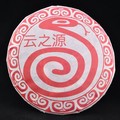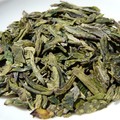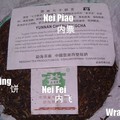Yunnan Sourcing - Teas - 2013
Tea by type
Tea by region
Tea by years and other
2013 Yunnan Sourcing "Year of the Snake Red Label" Ripe Pu-erh tea cake
 1 review
1 reviewA premium ripe tea composed entirely from 6 and 4 years aged ripe tea from Lincang. Light to medium fermentation spring material from old plantation tea trees gives this tea a strong taste and mouth-feel. Nice huigan and noticeable cha qi! Will develop more texture and nuances with the passing of years.
2013 Early Spring "Yunnan Bao Hong" Green tea
 1 review
1 review"Bao Hong" tea is from Yi Liang county of Yunnan. It's leaf is quite small and it carries a high level of aroma. The leaves are always picked when very small and fresh during a two hour window of time in the early morning of early March. The aroma is intense and fresh. It was first grown in the Tang Dynasty (A.D. 618-907) at the same time a Buddhist Monastery was built on Bao Hong Mountain. The original tea plant was brought by a visiting monk from Fujian. This tea has been growing on...
2013 "Light Roast" Wild Tree Purple Varietal Black Tea of Dehong
 1 review
1 reviewThis is a lightly processed black tea that was hand-crafted using a wild tree purple leaf varietal from Dehong prefecture. Ye Sheng "野生“ varietal aka "Camellia sinensis (L.) Kuntze var. assamica (J. Masters) Kitam." is a primeval varietal that pre-dates Camellia Sinensis var. Assamica and is a naturally occuring non hybridized varietal. It's potency in cha qi arises from it's unadulterated nature. It is naturally bug repellent, grows wild in the forests of Yunnan at an altitude of 1600-2200...
Theme
Quotes
„The process used to convert máochá into ripened pu'er is a recent invention that manipulates conditions to approximate the result of the aging process by prolonged bacterial and fungal fermentation in a warm humid environment under controlled conditions, a technique called Wò Dūi (渥堆, "wet piling" in English), which involves piling, dampening, and turning the tea leaves in a manner much akin to composting.“
Latest posts
01.01.2016 @ 18:14:35 - Eternal Spring:
WeRateTea.com wish you all the best for 2016!...
07.12.2015 @ 09:07:02 - sypalino:
I decided to taste this tea 2 weeks after delivery. The cake is lightly pressed, so...
09.11.2015 @ 21:58:19 - Eternal Spring:
Comparison of 2013 Bada Pu-erh.sk with <a...
09.11.2015 @ 09:34:07 - Eternal Spring:
Lao Yu 2013 is now about 2,5 years old tea and out of this 1,5 year stored in Europe....
09.11.2015 @ 09:33:11 - Eternal Spring:
Comparison of all three Lao Yu is now done :)
15.10.2015 @ 11:06:37 - Eternal Spring:
2015 Chawangpu Collection – I can only tell, that all teas are very good :)
09.10.2015 @ 10:31:19 - Eternal Spring:
It was quite long and difficult tasting to make a decision… There is still quite...
24.01.2015 @ 16:55:57 - Eternal Spring:
WeRateTea.com wish you all the best for 2015!...
30.12.2014 @ 17:19:22 - Eternal Spring:
"FT(For Taiwan)" means this brick was a special order of "Fei Tai" Company. Fei Tai...
13.08.2014 @ 18:24:28 - Eternal Spring:
We compared two teas from Youle. 2005 Jinuo Shan You Le "Red Sun Drum" and 2009...
Tea by region
We will help you with tea selection.
Do you like quality loose tea?
We will help you to find the right one for you. Be inspired by tea ratings of other tea lovers. Rating stars could help you.


Review your cup of tea.
Review the tea you are drinking and help other tea lovers to find the right cup of tea.






 Shops
Shops












